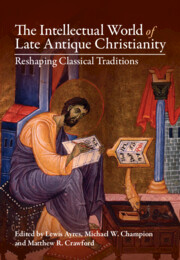74 results
1 - Modes of Knowing and Ordering Knowledge in Early Christianity
-
-
- Book:
- The Intellectual World of Late Antique Christianity
- Published online:
- 05 October 2023
- Print publication:
- 26 October 2023, pp 1-20
-
- Chapter
- Export citation
Preface
-
- Book:
- The Intellectual World of Late Antique Christianity
- Published online:
- 05 October 2023
- Print publication:
- 26 October 2023, pp xv-xvi
-
- Chapter
- Export citation
Notes on Contributors
-
- Book:
- The Intellectual World of Late Antique Christianity
- Published online:
- 05 October 2023
- Print publication:
- 26 October 2023, pp x-xiv
-
- Chapter
- Export citation
Contents
-
- Book:
- The Intellectual World of Late Antique Christianity
- Published online:
- 05 October 2023
- Print publication:
- 26 October 2023, pp v-viii
-
- Chapter
- Export citation
Plates
-
- Book:
- The Intellectual World of Late Antique Christianity
- Published online:
- 05 October 2023
- Print publication:
- 26 October 2023, pp ix-ix
-
- Chapter
- Export citation
Copyright page
-
- Book:
- The Intellectual World of Late Antique Christianity
- Published online:
- 05 October 2023
- Print publication:
- 26 October 2023, pp iv-iv
-
- Chapter
- Export citation
Bibliography
-
- Book:
- The Intellectual World of Late Antique Christianity
- Published online:
- 05 October 2023
- Print publication:
- 26 October 2023, pp 758-852
-
- Chapter
- Export citation
Index Locorum
-
- Book:
- The Intellectual World of Late Antique Christianity
- Published online:
- 05 October 2023
- Print publication:
- 26 October 2023, pp 853-883
-
- Chapter
- Export citation
General Index
-
- Book:
- The Intellectual World of Late Antique Christianity
- Published online:
- 05 October 2023
- Print publication:
- 26 October 2023, pp 884-912
-
- Chapter
- Export citation
Abbreviations
-
- Book:
- The Intellectual World of Late Antique Christianity
- Published online:
- 05 October 2023
- Print publication:
- 26 October 2023, pp xvii-xxii
-
- Chapter
- Export citation
Plate Section (PDF Only)
-
- Book:
- The Intellectual World of Late Antique Christianity
- Published online:
- 05 October 2023
- Print publication:
- 26 October 2023, pp 913-913
-
- Chapter
- Export citation

The Intellectual World of Late Antique Christianity
- Reshaping Classical Traditions
-
- Published online:
- 05 October 2023
- Print publication:
- 26 October 2023
Diagnostic stewardship for Clostridioides difficile testing in an acute care hospital: A quality improvement intervention
-
- Journal:
- Antimicrobial Stewardship & Healthcare Epidemiology / Volume 3 / Issue 1 / 2023
- Published online by Cambridge University Press:
- 05 April 2023, e67
-
- Article
-
- You have access
- Open access
- HTML
- Export citation
Endoscopic retrograde cholangiopancreatography and endoscopic ultrasound endoscope reprocessing: Variables impacting contamination risk
-
- Journal:
- Infection Control & Hospital Epidemiology / Volume 44 / Issue 9 / September 2023
- Published online by Cambridge University Press:
- 16 January 2023, pp. 1485-1489
- Print publication:
- September 2023
-
- Article
-
- You have access
- Open access
- HTML
- Export citation
1 - Of Scholarship, Piety and Community
-
-
- Book:
- Celsus in his World
- Published online:
- 18 November 2021
- Print publication:
- 25 November 2021, pp 36-68
-
- Chapter
- Export citation
Chapter 6 - Continuity and Change in Second-Century Christianity
- from Part II - Discerning Continuity and Discontinuity in Early Christianity
-
-
- Book:
- Christianity in the Second Century
- Published online:
- 04 May 2017
- Print publication:
- 15 May 2017, pp 106-121
-
- Chapter
- Export citation
Re-reading Gregory of Nazianzus. Essays on history, theology, and culture. Edited by Christopher A. Beeley. (CUA Studies in Early Christianity.) Pp. xiv+321 incl. frontispiece. Washington, DC: The Catholic University of America Press, 2012. $39.95. 978 0 8132 1991 2
-
- Journal:
- The Journal of Ecclesiastical History / Volume 65 / Issue 4 / October 2014
- Published online by Cambridge University Press:
- 11 September 2014, p. 878
- Print publication:
- October 2014
-
- Article
- Export citation
Notes on contributors
-
-
- Book:
- The Cambridge Companion to Augustine
- Published online:
- 05 July 2014
- Print publication:
- 05 June 2014, pp xiii-xviii
-
- Chapter
- Export citation
3 - Augustine on the triune life of God
- from Part I - The nature of God
-
-
- Book:
- The Cambridge Companion to Augustine
- Published online:
- 05 July 2014
- Print publication:
- 05 June 2014, pp 60-78
-
- Chapter
- Export citation
The Trinity and the Life of the Christian: A Liturgical Catechism
-
- Journal:
- New Blackfriars / Volume 92 / Issue 1037 / January 2011
- Published online by Cambridge University Press:
- 01 January 2024, pp. 3-17
- Print publication:
- January 2011
-
- Article
- Export citation



